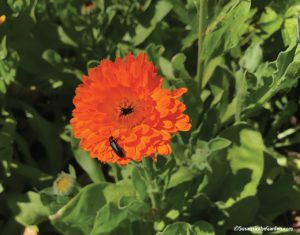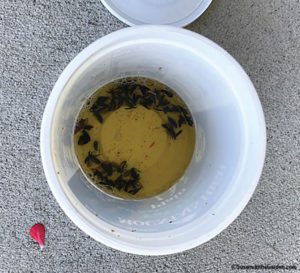Blister Beetles, Black
Latin name: Epicauta puncticollis
Size: About 1/2 inch
Color: Black
Life cycle: The adult females lay groups of up to 100 eggs in the soil, which hatch in about 2 weeks. The larvae typically feed on grasshopper eggs, or — more alarmingly — the larval cells of solitary bees. They overwinter in the soil and pupate in the spring. Thankfully, blister beetles only have one generation per year.
Symptoms of their activity: I have primarily seen them on the flower heads of calendulas (Pot marigold), where they eat the flower petals. Since calendulas produce edible flowers, this is not a good thing! However, certain types of blister beetles affect other crops such as potatoes and hay. The beetles produce a chemical called cantharidin which is toxic to livestock, dogs, cats and humans.
Typically seen on: Calendulas; also potatoes and hay.
Controls: Hand-picking (knock them into container of soapy water). I have had very good luck with this method (see photo to right), and since the beetles only produce a single generation in a year’s time, they can be easy to get ahead of.
Cultural controls: Keep the beetles in check with hand-picking.
Natural predators: I was not able to locate any.
Additional information: Washington State University factsheet on Blister Beetles and Montana State University Blister Beetles.
Back to Organic Pest Control


